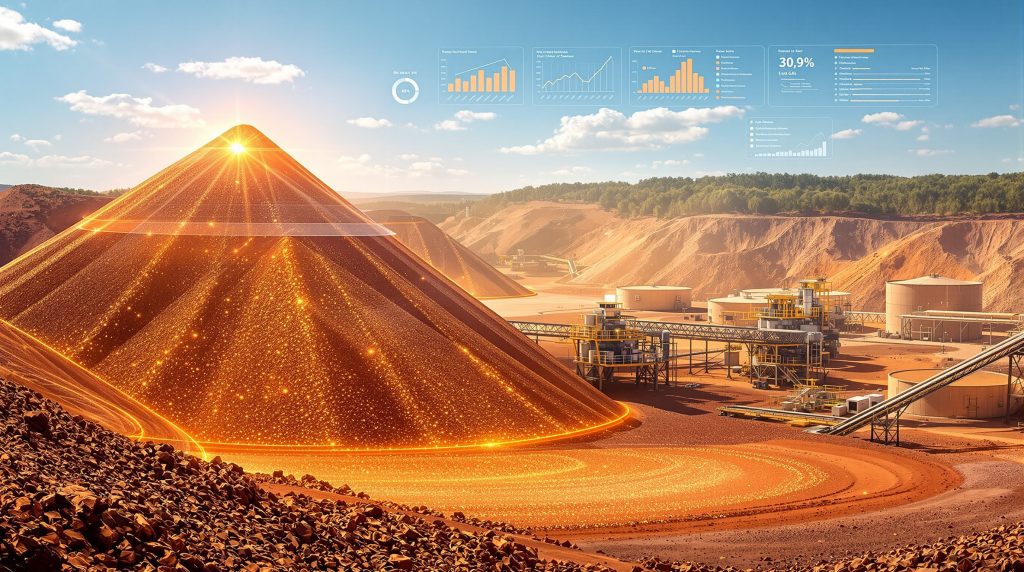Re-Mining Copper Tailings: Transforming Mining Waste into Valuable Resources
The mining industry is experiencing a significant transformation as companies increasingly turn to tailings re-processing to recover valuable metals. With declining ore grades at existing mines and longer development timelines for new projects, re-mining copper tailings offers a compelling solution to meet growing copper demand while addressing environmental concerns.
The Scale of Untapped Resources in Mining Waste
Between 1910 and 2010, approximately 100 million tons of copper never reached the market, remaining trapped in tailings ponds, according to research from Germany's Fraunhofer Institute. This represents a significant untapped resource as the world extracted 650 million metric tons of copper during this period.
Current global tailings production exceeds 7 billion tons annually and continues to rise as ore grades decline across existing mining operations.
Historical tailings often contain copper concentrations ranging from 0.1-0.5%, while modern tailings typically contain less than 0.1%, though both can be economically viable with advanced recovery technologies when multiple metals are recovered simultaneously.
Environmental Benefits of Tailings Re-Processing
Reduces the environmental footprint of mining by extracting value from existing waste rather than developing new mines.
Minimizes the need for new mine development and associated land disturbance, which can take 8-10 years from planning to commissioning.
Addresses potential acid mine drainage and heavy metal contamination from legacy tailings that pose long-term environmental risks.
Supports sustainable resource management and circular economy principles by transforming waste into valuable resources.
What Technologies Make Copper Tailings Re-Mining Economically Viable?
The economics of re-mining copper tailings have improved dramatically with technological advancements in mineral processing, leaching, and digital optimization. These innovations allow for profitable recovery of metals from materials previously considered waste.
Advanced Flotation and Concentration Techniques
Modern flotation technologies can achieve copper recoveries of approximately 30% from tailings, a significant improvement over historical capabilities.
Enhanced grinding technologies like Glencore's ISAMill reduce energy consumption while improving metal recovery, handling increasingly coarser particle sizes to save water and reduce waste.
Optimized reagent combinations and process conditions specifically designed for tailings material enhance separation efficiency and selectivity.
Improved sensor technologies enable real-time adjustments to processing parameters, maximizing recovery from variable tailings compositions.
Innovative Leaching and Extraction Methods
The Albion Process developed by Glencore Technology can achieve copper recovery rates exceeding 99% from complex ores while reducing operating costs by up to one-third.
Bio-leaching approaches use naturally occurring or engineered microorganisms to selectively extract metals from tailings while minimizing environmental impact.
Heap leaching modifications specifically designed for tailings material characteristics improve permeability and metal liberation.
Selective chemical leaching targeting specific minerals while minimizing reagent consumption improves both economics and environmental performance.
Artificial Intelligence and Digital Transformation
Digital twin technology creates virtual replicas of mining processes for optimization without disrupting actual operations, enabling continuous improvement.
AI in drilling operations and predictive models identify optimal processing parameters for variable ore types, with BHP implementing this technology at its South Australian copper mine and Escondida mine in Chile.
Real-time data analytics enable continuous process adjustments to maximize recovery, detecting patterns in tailings composition that would be impossible for human operators to identify.
When AI mill drive optimization was trialed at Freeport-McMoRan's Baghdad mine in Arizona, it resulted in a 5-10% increase in copper production, demonstrating the practical benefits of technology integration.
Which Companies Are Leading Copper Tailings Re-Mining Projects?
Major mining companies and specialized firms are pioneering tailings reprocessing technologies and projects, recognizing both the economic opportunity and environmental benefits.
Major Mining Companies Embracing Tailings Recovery
Rio Tinto has successfully extracted critical metals like scandium and tellurium from waste streams at existing operations, demonstrating the multi-metal recovery potential of tailings processing.
BHP employs generative AI at Escondida mine to optimize ore blasting and blending strategies, identify challenging ore characteristics, and support the implementation of SAG mill model predictive control.
Freeport-McMoRan's AI implementation across North American operations is projected to increase annual copper production by 90,000 tons, equivalent to a new processing plant that would cost over $1.5 billion and require 8-10 years for development.
Glencore Technology continues developing improved grinding and leaching technologies specifically designed for tailings reprocessing applications.
Specialized Projects Targeting Legacy Tailings
Hudbay Minerals is evaluating tailings re-mining at the century-old Flin Flon site in Manitoba, Canada, which closed in 2022 after leaving nearly a century's worth of minerals-rich waste.
Hindustan Zinc is making the largest commitment to tailings reprocessing with a $438 million investment to process 10 million tons per year of tailings at its Rampura Agucha mine, the world's largest zinc mine.
Cobalt Blue Holdings has signed an agreement with Mount Isa city council in Queensland to explore re-working pyrite tailings as a potential alternative source of sulphur once the town's copper smelter closes.
Various junior mining companies are specializing in tailings reprocessing technologies, developing innovative approaches to metal recovery from waste materials.
What Economic Factors Drive Tailings Re-Mining Decisions?
The business case for re-mining copper tailings depends on several interconnected economic factors that determine project viability and potential returns.
Cost-Benefit Analysis of Tailings Re-Processing
Avoided costs of new mine development, estimated at over $1.5 billion for comparable production capacity, significantly improve project economics.
Reduced timeline compared to new mines (1-3 years versus 8-10 years for new operations) enables faster return on investment and reduced exposure to commodity price volatility.
Lower capital intensity as existing infrastructure can often be leveraged or modified rather than constructed from scratch.
Potential revenue from multiple metals recovery beyond just copper enhances project economics compared to single-metal focused operations.
Market Conditions Supporting Tailings Re-Mining
| Factor | Impact on Tailings Re-Mining Viability |
|---|---|
| Copper Price | Higher prices (currently $4.5715/lb) improve project economics and expand the range of viable tailings deposits |
| Energy Costs | Lower energy requirements compared to conventional mining reduce operational expenses |
| Environmental Regulations | Stricter regulations incentivize waste reduction and can create permitting advantages |
| Critical Minerals Demand | Recovery of by-products like tellurium and scandium enhances project value |
| ESG Investment Criteria | Improved sustainability metrics attract investment from funds with environmental mandates |
Operational Efficiency Improvements
5-10% production increases demonstrated in pilot projects using AI optimization translate to significant revenue improvements at current metal prices.
Reduced water consumption through improved tailings management addresses both environmental concerns and operational costs.
Lower energy requirements compared to conventional mining operations improve both economics and environmental performance.
Potential for continuous rather than batch processing enhances throughput and utilization of processing assets.
How Does Tailings Re-Mining Support Sustainable Mining Practices?
The re-mining of copper tailings represents a significant shift toward more sustainable resource management in the mining industry.
Circular Economy Applications in Mining
Transforms waste materials into valuable resources, demonstrating the mining industry's capacity for innovation and environmental stewardship.
Reduces the overall environmental footprint of metal production by extracting additional value from previously processed materials.
Creates economic value from previously discarded materials, improving resource efficiency and utilization.
Supports the concept of "urban mining" from anthropogenic deposits, reducing the need for new resource extraction.
Reduced Environmental Liabilities
Decreases the volume of stored tailings requiring long-term environmental management and monitoring, minimizing long-term risks.
Minimizes the risk of tailings dam failures through volume reduction, addressing one of the mining industry's most significant environmental hazards.
Lowers potential for acid mine drainage and metal leaching into groundwater by removing reactive minerals.
Enables more comprehensive mine reclamation innovation after processing, supporting better closure outcomes.
Social License Benefits
Demonstrates commitment to responsible resource management, improving relationships with local communities and regulators.
Creates employment opportunities in communities with legacy mining operations, extending economic benefits beyond active mining periods.
Reduces the need for new mine development in sensitive areas, minimizing conflicts over land use and environmental impacts.
Improves public perception of the mining industry's environmental practices, potentially easing approval processes for other operations.
What Challenges Must Be Overcome in Tailings Re-Mining Projects?
Despite the promising potential, re-mining copper tailings presents unique technical, economic, and regulatory challenges that must be addressed.
Technical Limitations and Solutions
Variable mineral composition in legacy tailings creates processing challenges that require adaptive approaches and flexible plant designs.
Fine particle sizes in tailings demand specialized separation techniques that may not be required in conventional ore processing.
Potential contaminants accumulated during tailings storage can affect recovery efficiency and require additional processing steps or reagent modifications.
Weathering and oxidation of stored tailings over decades can significantly change mineral characteristics compared to original processing conditions.
Economic Viability Considerations
Capital expenditure requirements for specialized equipment must be carefully balanced against projected metal recovery and market prices.
Operating costs versus recoverable metal value determine the cut-off grade for economically viable tailings processing.
Market price volatility affecting project economics requires robust financial modeling and potentially hedging strategies.
Economies of scale needed for commercial viability may limit the application to larger tailings deposits or central processing facilities.
Regulatory and Permitting Issues
Unclear regulatory frameworks for tailings reprocessing in some jurisdictions create uncertainty around approval processes and timelines.
Environmental assessment requirements for disturbing legacy tailings may be complex due to potential historical contamination.
Liability concerns regarding historical contamination can complicate project development and financing.
Permitting timelines potentially affecting project schedules may reduce the responsiveness to favorable market conditions.
How Are Tailings Re-Mining Technologies Evolving?
The field of tailings reprocessing is experiencing rapid technological evolution, with innovations improving both recovery rates and environmental performance.
Emerging Innovations in Tailings Processing
Bio-ingenuity approaches like Allonnia's D-Solve technology use microbes to selectively extract impurities, with laboratory tests showing potential for 18% improvement in metal grades and 40% reduction in specific impurities.
Enhanced gravity separation techniques for fine-grained materials improve recovery of dense valuable minerals while minimizing reagent use.
Advanced sensor technologies for real-time tailings characterization enable precise blending and processing parameter optimization.
Dry processing methods reducing water consumption and environmental impact address one of the most significant environmental challenges in mining.
Integration with Renewable Energy
Solar-powered leaching operations reduce carbon footprint and operating costs, particularly at remote sites with high fuel transportation costs.
Electrification of processing equipment reduces both emissions and maintenance requirements compared to diesel-powered alternatives.
Energy recovery systems from process heat improve overall energy efficiency and reduce operating costs.
Microgrid implementations at remote tailings sites enhance energy security and enable operations in areas with limited grid infrastructure.
Future Directions in Tailings Management
"Design for re-mining" approaches in new tailings facilities prepare for eventual reprocessing from the start of operations.
Continuous monitoring and characterization of tailings deposits improve understanding of resource potential and optimal processing methods.
Integration of tailings reprocessing into mine closure planning creates economic activity post-mining while addressing environmental liabilities.
Development of mobile processing plants for smaller tailings deposits expands the range of economically viable projects.
What Are the Global Implications of Copper Tailings Re-Mining?
The widespread adoption of tailings reprocessing could significantly impact global copper supply, environmental outcomes, and resource management practices.
Resource Security and Supply Chain Resilience
Reduces dependence on new mine development for copper supply, potentially addressing projected supply gaps more rapidly.
Diversifies sources of critical minerals for technology manufacturing, improving supply chain security.
Shortens supply chains by utilizing existing domestic resources rather than developing new mines in remote locations.
Mitigates geopolitical risks associated with concentrated mining regions by enabling more distributed production.
Climate Change Mitigation Contributions
Supports the energy transition through increased copper availability for renewable energy infrastructure and electrification.
Reduces greenhouse gas emissions compared to conventional mining due to lower energy requirements and avoided land disturbance.
Minimizes land disturbance and associated carbon release from soil and vegetation removal.
Enables more efficient resource utilization with lower environmental impact per ton of metal produced.
Case Studies: Successful Tailings Re-Mining Projects
Freeport-McMoRan's Baghdad mine in Arizona achieved 5-10% production increase through AI optimization, demonstrating the potential of digital technologies.
Rio Tinto's successful extraction of tellurium from copper processing waste streams shows the potential for critical minerals recovery from tailings.
Hindustan Zinc's large-scale commitment to process 10 million tons of tailings annually illustrates commercial-scale implementation.
Various smaller-scale pilot projects are demonstrating technical feasibility across different tailings types and mining regions.
FAQs About Copper Tailings Re-Mining
What is the typical copper content in tailings deposits?
Copper content in tailings varies widely depending on the age of the operation, original ore grade, and processing efficiency. Historical tailings may contain 0.1-0.5% copper, while modern tailings typically contain less than 0.1%. However, even these lower concentrations can be economically viable with advanced recovery technologies and when multiple metals are recovered simultaneously.
How does re-mining compare economically to traditional mining?
Re-mining tailings generally requires lower capital investment than new mine development, with faster implementation timelines (1-3 years versus 8-10 years) and reduced permitting complexity. While metal recovery rates may be lower, the absence of mining costs and utilization of existing infrastructure often makes tailings reprocessing economically attractive, especially during periods of high copper price prediction increases.
What environmental risks are associated with disturbing old tailings?
Disturbing legacy tailings can potentially release dust, mobilize contaminants, or alter drainage patterns. However, properly managed re-mining operations incorporate comprehensive environmental controls and ultimately reduce long-term environmental liabilities by removing metals that could otherwise leach into the environment and reducing the volume of stored tailings.
Can tailings re-mining completely eliminate mining waste?
While tailings re-mining significantly reduces waste volume and recovers valuable metals, it typically doesn't eliminate tailings entirely. However, the resulting processed material often has lower environmental risk and can be used for construction materials, mine backfill, or other beneficial applications, moving toward a zero-waste mining model.
What role does artificial intelligence play in tailings re-mining?
AI technologies optimize processing parameters in real-time, predict maintenance needs, identify optimal blending strategies, and enhance metal recovery rates. Machine learning algorithms can detect patterns in tailings composition and behavior that would be impossible for human operators to identify, significantly improving project economics. BHP and Freeport-McMoRan have demonstrated 5-10% production increases through AI implementation.
Conclusion: The Future of Copper Supply Through Tailings Innovation
The re-mining of copper tailings represents a significant opportunity to address both resource scarcity and environmental concerns in the mining industry. As technology continues to advance and economic conditions evolve, tailings reprocessing is likely to become an increasingly important component of global copper supply.
By transforming what was once considered waste into valuable resources, the mining industry is demonstrating its capacity for innovation and sustainability. The combination of traditional mining expertise with cutting-edge technologies like artificial intelligence, bio-engineering, and advanced processing methods is creating a more efficient, less wasteful approach to resource extraction.
As the world's demand for copper continues to grow, driven by electrification, renewable energy, and digital technologies, tailings re-mining offers a promising pathway to meet this demand while minimizing environmental impact. This quiet revolution in the mining sector may well prove crucial to enabling the global transition to a more sustainable future, with copper investment insights suggesting continued growth in this area.
Ready to Invest in the Next Major Mineral Discovery?
Discovery Alert instantly notifies investors of significant ASX mineral discoveries using its proprietary Discovery IQ model, turning complex mineral data into actionable insights. Understand why historic discoveries can generate substantial returns by visiting Discovery Alert's dedicated discoveries page and begin your 30-day free trial today to position yourself ahead of the market.




